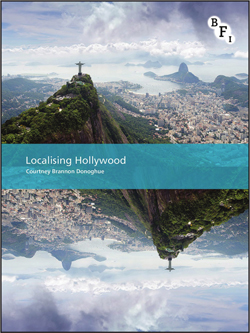Book Review
Brannon Donoghue, Courtney. Localising Hollywood. (London: British Film Institute/Palgrave, 2017.)
Skip other details (including permanent urls, DOI, citation information)
: This work is licensed under a Creative Commons Attribution-NonCommercial-NoDerivatives 4.0 International License. Please contact [email protected] to use this work in a way not covered by the license.
For more information, read Michigan Publishing's access and usage policy.
In Localising Hollywood, Courtney Brannon Donoghue presents her extensive fieldwork and interviews with media practitioners in Brazil, Spain, Germany, France, Belgium, the United Kingdom, and the United States. Through these interactions, she examines the tensions between the macro-level forces of global Hollywood conglomerates and the micro-level contexts of media professionals working in territory offices and local production studios around the world. This approach provides a contrast to the political economy method of understanding global media industries found in Toby Miller et al.’s Global Hollywood 2: “Global Hollywood [and other political economy scholarship on global media institutions] takes an overly deterministic view of the studios as global institutions. Hollywood is presented as a monolithic entity.”[2] Brannon Donoghue aims to place media professionals’ day-to-day practices within their historical, structural, and cultural contexts to complicate political economic understandings of the globalization of Hollywood.
From the 1980s to the present, Hollywood film studios became increasingly reliant on international box office performances, which now produce more gross revenue than the domestic market. During the same time period, Hollywood studios underwent major structural changes due to widespread conglomeration and convergence. Brannon Donoghue argues, “as the film studios found themselves positioned inside larger global and more diversified media conglomerates, their approach to international markets shifted from universally global to specifically local.”[3] To continue growing international revenues and to specify strategies for local markets, Hollywood studios’ international divisions began relying on specialized territory offices to localize content for key international markets. The development of these local territory offices historically aligns with the deregulation of film industries and localized policy incentives for production companies to work within a specific region.
While the number of employees and scope of work vary for each territory office depending on the size of its regional market, local territory offices constantly negotiate global studios’ business priorities and local markets’ specific cultural conditions. Many of the territory office managing directors are native citizens of the countries in which they work and are hired from the local film and television market. Because of their fluency in the local language, culture, and industry, managing directors and territory office employees “serve as cultural intermediaries navigating content, culture, and strategies of the studio but also adapting business tactics to policies and trends in their local markets.”[4] While Brannon Donoghue notes myriad ways territory offices negotiate studio interests and local contexts, two main strategies appear repeatedly throughout the book: first, localizing the development, marketing, and distribution of global films and television series, and, second, forming local-language production partnerships.
Despite common scholarly and popular rhetoric about Hollywood’s generic worldwide distribution strategies, Brannon Donoghue demonstrates how studios’ international divisions tailor release strategies and films to fit strategic international markets. Territory offices play key roles in this local tailoring. First, they schedule and program the releases of studio films to best meet the conditions of the local market by situating the films’ releases within the broader release schedule of other studios’ films and local productions, the availability of quality theater screens within the region, and regionally specific cultural events and holidays. Second, territory offices develop marketing strategies and content specific to their regions. The amount of agency the local offices have to localize marketing content varies from studio to studio, but can go as far as editing movie trailers, posters, and other promotional materials to showcase actors, locations, and themes that resonate with local audiences. Finally, territory offices negotiate windowing strategies beyond studio films’ theatrical releases in ancillary and television markets. Through these processes, the mid-level management of territory offices shapes how local audiences interact with and perceive films by placing their studio’s financial interests within a localized framework.
Beyond assisting Hollywood studios with tailoring release strategies for local markets, territory offices play a critical part in local markets by partnering with local production companies to create local-language productions. Although these productions make up a relatively small percentage of any individual region’s film market, major studios’ coproductions of local-language films break from traditional narratives of American media’s international dominance. Brannon Donoghue demonstrates how local media practitioners create these films with local audiences in mind. While English-language studio films rely on both domestic and international box offices for financial success, local-language productions rarely travel outside of local markets. Studios see these local-language productions as symbolic, not monetary, investments. By participating in local-language productions, territory offices build relationships with local media businesses that help them accomplish other types of work and retain remake rights for their studio, an important piece of cultural investment as intellectual property becomes increasingly valuable for studios. At the same time, local production companies may benefit from these partnerships through the funding they receive from major studios and the feedback they receive from local territory offices’ directors of production. Of the many scholarly contributions Brannon Donoghue makes, her work on local-language productions provides one of Localising Hollywood’s most beneficial insights.
Brannon Donoghue uses local-language production practices to make more in-depth arguments about global media industries that expand beyond their global and local benefits. Citing case studies that highlight how the local and global consistently interact,[5] she demonstrates that global Hollywood directly and indirectly takes part in developing local culture industries. Citing Michael Curtin’s concept of media capitals, or “meeting places where local specificity arises out of migration, interaction, and exchange,”[6] Brannon Donoghue problematizes understandings of runaway productions as individual events. She instead claims that studies on runaway productions do “not address the material and symbolic infrastructure and increasingly complex relationships of Hollywood studios with local industry networks.”[7] Global studios’ involvement within local regions can support existing creative industries and open new production units. Through this intervention, Brannon Donoghue continues to push for more contextualized understandings of global media industries.
Global studios’ localization strategies act as both short-term reactionary strategies and consistent long-term strategies for building their presence within a region. Throughout many of the chapters, Brannon Donoghue highlights how individual studios have succeeded and failed through these efforts. By demonstrating the constantly shifting localization strategies of global Hollywood studios and their mixed successes, Brannon Donoghue highlights the fallibility of Hollywood conglomerates and greatly enhances her argument about the problems with viewing Hollywood as a monolithic entity driving American products into international markets.
Although the book offers many useful interventions, some of the arguments in Localising Hollywood are slightly disconnected. First, Brannon Donoghue breaks apart information about territory offices across multiple chapters, attempting to separate the labor practices of a few key individuals (chapter 4) and overall local-language production strategies (chapter 3). The separation between the practices of these key individuals and localization strategies is not as clearly delineated as the ideas presented in many of the other chapters. Second, the book provides a fascinating and illuminating examination of the Motion Picture Association of America’s structure and global strategy based on Brannon Donoghue’s unprecedented access to the regulating body (chapter 6), but this section stands out from the rest of the book because it breaks from the on-the-ground view of management practices. Outside of these minor critiques, Localising Hollywood presents a strong argument useful for future scholarship and coursework in global media studies, production studies, and film studies.
Ryan Stoldt is a PhD candidate at the University of Iowa. His research focuses on how new media industries address risk in their production decisions, focusing specifically on digital television portals such as Netflix, Hulu, and Amazon Prime.

Courtney Brannon Donoghue, Localising Hollywood (London: British Film Institute/Palgrave, 2017), 5.

For example, the production of the Harry Potter films at Leavesden Studios employed more than four thousand local workers from London.a
Michael Curtin, “Media Capital: Towards the Study of Spatial Flows,” International Journal of Cultural Studies 6 , no. 2 (June 2003): 204.

Bibliography
- Brannon Donoghue, Courtney. Localising Hollywood. London: British Film Institute/Palgrave, 2017.
- Curtin, Michael. “Media Capital: Towards the Study of Spatial Flows.” International Journal of Cultural Studies 6, no. 2 (June 2003): 202–28.


